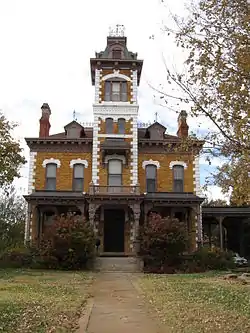Lebold Mansion
Lebold Mansion is a Victorian-era house in Abilene, Kansas, USA. Lebold Mansion was added to the National Register of Historic Places in 1973.
C. H. Lebold House | |
 | |
  | |
| Location | Abilene, Kansas |
|---|---|
| Coordinates | 38°54′56.02″N 97°13′24.27″W |
| Built | 1880 |
| Architectural style | Renaissance |
| NRHP reference No. | 73000751 [1] |
| Added to NRHP | May 8, 1973 |
History
Constructed of native Kansas limestone, the mansion was built in 1880 by banker Conrad Lebold.
In 1857 Tim and Eliza Hersey, the founders and first inhabitants of Abilene, built a stone dugout in the location where the Lebold Mansion stands today. The Hersey dugout was incorporated into the construction of the mansion's tower and is preserved as part of the foundation located at the tower's base. Visitors still can view the dugout when touring the home.[2]
The Mansion has served many purposes over the years. In the 1920s it was redecorated by C. L. Brown as a boarding house for the young female operators of his United Telephone Company.[3] In 1930 it became an orphanage and then served as an apartment building from 1940–1970.
The house was added to the National Register of Historic Places in 1973.
It has survived intact and was maintained as a historic house museum from 1973 until 2010. It was considered to be one of the finest Victorian decorative art museums in the midwest. It was featured in Victorian Homes Magazine and Victorian Decorating Magazine.
In 2010, it was sold to new owners as a private residence. Its 23 rooms have been redecorated with period furniture, wallpaper, drapes, and other furnishings.
References
- "National Register Information System". National Register of Historic Places. National Park Service. January 23, 2007.
- http://www.abilenekansas.org
- Sondra van Meter McCoy (Summer 1982). "Patriarch of Abilene: Cleyson L. Brown and the United Empire, 1898-1935" (PDF). Kansas History. Kansas Historical Society: 113. Retrieved 2019-06-29.
His paternal concern foe his employees extended to housing for the young female operators of the United Telephone Company. A welfare department he set up redecorated the stately Victorian Lebold mansion, left, which was operated similarly to a college sorority house for the young women.
